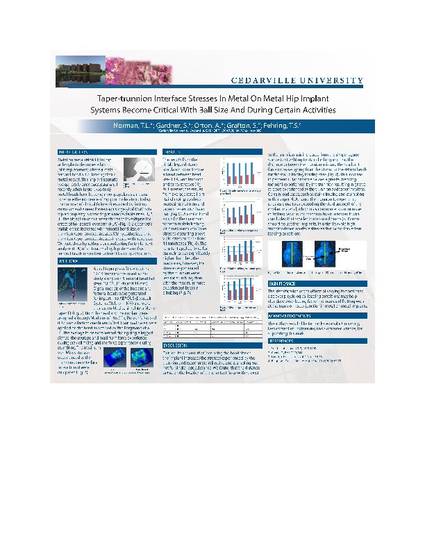
- Metal on metal implants,
- trunnion-taper junction,
- HLA,
- fretting corrosion
Metal on metal (MoM) total hip arthroplasty describes a hip joint replacement where a metal (cobalt chromium) femoral head articulates against a metal socket. This implant scenario has generally been successful until recently when larger (> 36 mm) metal heads have become more popular as a means to reduce the incidence of hip joint dislocation. Today, the number of clinical failures (described by fretting corrosion and a need for revision surgery) of MoM total hip arthroplasty is occurring at unacceptable rates. The objective of our research was to investigate the effect of horizontal lever arm (HLA), a geometric variable that increases with femoral head size, on trunnion-taper contact stresses. We hypothesized that trunnion-taper contact stresses increase with head size. Such increases may be responsible for increases in the potential for fretting wear and subsequent corrosion. We tested our hypothesis by conducting finite element analysis (FEA) of a titanium alloy hip stem and five femoral heads under four different loading conditions. The implant and head were assembled in such a way to simulate a Morse-taper fit. Four load cases were applied: the average force experienced during single legged stance, the average and maximum force experience during stair climbing and the force experienced during stumbling. The maximum von Mises stresses experienced at the trunnion-taper interface for each load were compared. Our results showed that increasing the head size of the implant increases the stresses experienced by the trunnion and taper for stairclimbing and stumbling due to the offset in loading with respect to the trunnion axis. Certain load cases, such as stair climbing and stumbling, with a larger HLA cause the trunnion to experience stresses close to or exceeding the yield strength of the implant material, which may contribute to an increase in fretting wear at the trunnion-taper junction. It was concluded that smaller to mid-sized heads (≤ 36mm) should be used for implants, in order to avoid high trunnion-taper interface stresses that occur for certain loading conditions.
Available at: http://works.bepress.com/timothy_norman/9/
